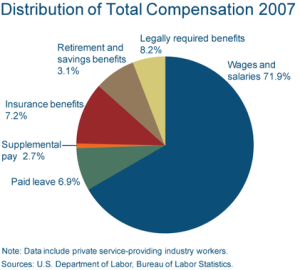Have you ever heard of a hidden paycheck pie chart? It’s a chart that shows employees how much you’re forking out in benefits on
top of what you’re paying them. It’s pretty impressive, when you look at it. Especially given that most employees have no idea how much companies are spending on their benefits packages.
Historically, companies didn’t share this information. But smart companies are realizing that, considering all they spend on health and dental, 401K matching, stock options and the cost of paid time off and paid holidays, it’s a good idea to be transparent. When you break down how much a company contributes per employee on each of those things, which can add up to an additional $300-to-$1,000 a month, it often transforms employees and candidates perception and understanding of what the company provides for their work.
If you’re looking to recruit, this helps a candidate get a really clear understanding of the value of what you offer, so he can compare apples to apples and you don’t wind up in a war over base salary. If you are looking to retain a key employee, this can be a helpful annual reminder–say during the benefit open enrollment period or pay raise time–of how much the company values her. If you’re matching 401K contributions, employees should be given a clear visual how this helps them quickly amass retirement savings. There’s little value in offering these benefits if they’re not useful in retaining employees and helping them stay motivated.
It is a well known fact in the HR and benefits world that employees suffer sticker shock on the true cost of benefits when they need to pick up the entire tab via COBRA or state continuation. Why wait until that employee has resigned, been terminated or had a reduction of hours, to discover how much it really costs?
Of course, it’s also key to make sure that the benefits you’re offering are the ones your employees really value. If your employees don’t care about dental, for example, they’re not going to be impressed with how much you’re spending on it. If what they want is more paid time off, you’re not going to win with offering some other benefit that’s not as valuable to them. How do you know what they want? Well, how about asking them? I’ve written about this in a previous post. Create a survey, gather their feedback on the current benefit plans and what they want in future benefits (given cost constraints), and then show them how their input designed the plans they receive. And if you want help figuring out what benefits will lure the best people and how you should administer them, call us!
We work with companies on a project basis or on retainer, providing a custom level of HR help designed for your business. Contact me at Caroline@valentinehr.com or call (512) 420-8267.




